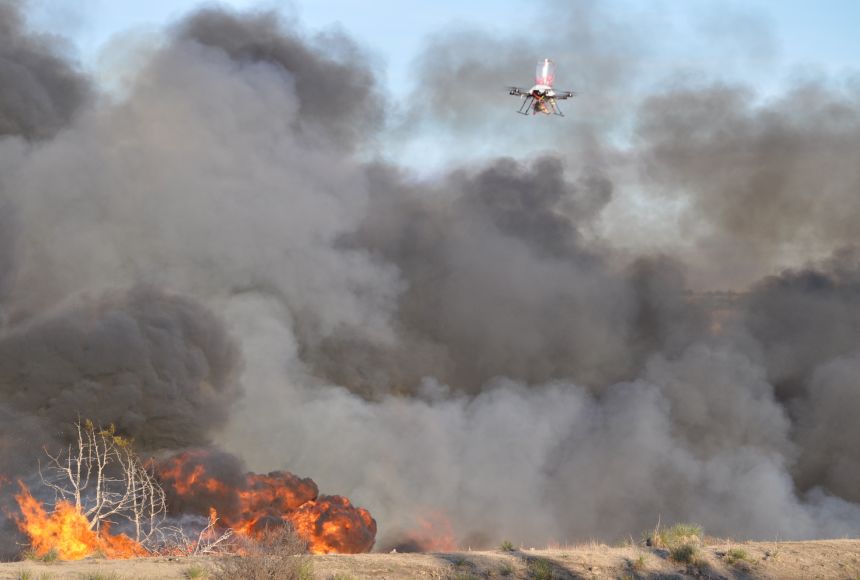The sea of native grassland that once carpeted the United States' Great Plains has steadily been disappearing—replaced at a disconcerting rate by trees and shrubs. The main tool used to drive out the trees and encourage the grasses is fire—and controlled burns are set every few years throughout parts of the Plains states to sweep the landscape clean.
Yet these fires have not halted the advance of trees and shrubs. Now, Dirac Twidwell, a range ecologist at the University of Nebraska, says he’s figured out why.
The problem is not that controlled burns are too destructive, he says. It’s that they’re not destructive enough. More extreme fire is needed, he argues, because extreme fire is more effective at killing deeply rooted shrubs and clearing the way for fast-growing grasses to thrive.
And he’s developed a new tool to improve the odds: fireball igniters known as “dragon eggs” launched by drones. Plastic spheres the size of ping-pong balls are lobbed out of a two-pound unmanned aerial system, or miniature drone, to help the controlled fire burn.
“People understand the amount of deforestation occurring in tropical rainforests,” Twidwell says. “But we also have a completely different shift in the Great Plains, from grassland to trees that has undesirable consequences equivalent to deforestation.”
Historically, fires set by lightning burned naturally at regular intervals across the Great Plains. Native Americans, who saw the benefits, periodically burned the prairie to improve grazing conditions for buffalo. As the Plains was settled and grassland converted for crops and grazing, fires were seen as a threat and extinguished. In the last 50 years, as woody plants began increasing and transforming the grassland into a shrub ecosystem, fire has returned to the Plains in the form of controlled burns.
But there is a difference between the historic patterns of natural fires and human-made ones. Modern controlled fires are often low-intensity—in part because fire managers are leery of deploying extreme fire, which can behave erratically, burn in nonlinear directions, and create firestorms.
Twidwell began testing extreme fire several years ago in Texas during a drought and in the Nebraska Sandhills. He found that it burned easily through woody juniper canopy and that the grasses recover easily. Two years after burns, the test plots had no bald or eroded patches.
“Nobody is really studying high intensity fire, because everyone would think you are crazy,” Twidwell says. But fire, he argues, is the “stabilizing force” of the Great Plains.
An Idea that Began as a Joke
The idea to use a drone began as a joke between Twidwell and his colleague, Craig Allen, a researcher with the U.S. Geological Survey in Nebraska. Then they took the idea to the Nebraska Intelligent MoBile Unmanned Systems Lab, where the mini drone known as a hexacopter was developed. It can also be used to help manage controlled burns in western forests, where dry tinder on the forest floor is burned to prevent small fires from becoming megafires, and to aid firefighters trying to prevent wildfires from spreading.
Twidwell says the use of drones enables fires to be managed more safely and cheaply. Twidwell and Allen's research was published in Frontiers in Ecology and the Environment. Twidwell presented the findings at a meeting of the Ecological Society of America in Fort Lauderdale, Florida, in August 2016.
Dragon's Eggs
The fire-igniters became known as “dragon’s eggs” because they transform once they are injected with chemicals.
“It takes a full minute from the injection before you get combustion,” Twidwell says. “As they heat up, you can see them start to glow on the inside. It’s a pretty brilliant name. I wish I’d come up with it.”
The U.S. Forest Service already uses unmanned aerial vehicles to monitor forest wildfires, and the agency also uses fires of various intensities in managed burns in forests. Richard Bahr, a senior official with the forest agency’s Office of Fire and Aviation Management, describes a test of Twidwell’s drone and its “dragon-egg” igniters as a “good learning experience” that works best in small fires or in the grasslands.
“This is a tool. It provides an opportunity,” he says. “If I only need to go out and drop a half-dozen of these, it is the way to go. If I have to drop a thousand of them, I am going to want a helicopter.”
